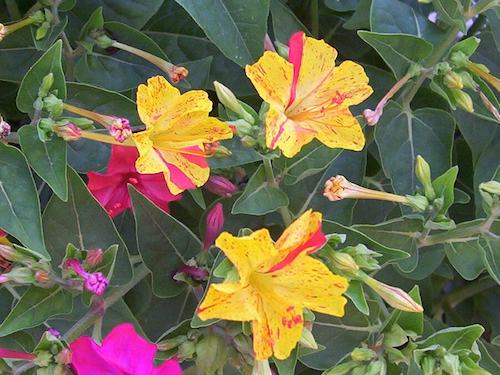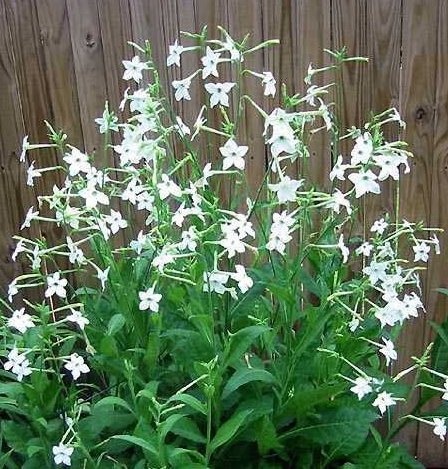The Moonlight Garden
By Ray Novitske, Fairfax Master Gardener

Datura innoxia
During the summer evenings, I enjoy hosting friends for dinner on my outdoor deck. As an avid gardener, the gang with their wine glasses in tow tour my gardens before dinner, sometimes as the sun goes down or later. I began to take notice of those evening plants that put on a show during the evening and discovered the concept of the moonlight garden.
This type of garden is designed to be enjoyed during the evening. Now, I do not have a designated moonlight garden, but do have a number of plants scattered around that are most appreciated after the sun goes down. I placed some of these on the following list, as well as those that other sources have agreed belong in the moonlight garden.
There are a few attributes that qualify to be in a moonlight garden. The first is color. A white flowering plant is more easily seen and shows up in limited light. But, any lighter color will do, whether on flowers or on contrasting leaf patterns such as streaked or dual-tone hostas. Trees with light colored bark such as river birch also show well at night.
Another attribute is fragrance. With limited sight, the sense of smell becomes the way to appreciate a night garden. A third attribute is bloom time. Plants that bloom at night, or exclusively bloom at night, are found in a moonlight garden. Most likely these developed to attract certain species of moths for pollination.
Jimsonweed Datura Innoxia, D. wrightii, D. meteloides
White | Fragrant | Night blooming
This is sometimes called a moonflower and confused with another similar plant. The large trumpet shaped blooms open only at night, releasing an intoxicating sweet fragrance, and last only one night. The plant grows up to 4 feet tall (120 cm) and is considered an annual, although some underground roots survive our winters and reappear in the spring. I occasionally see a sphinx moth or hummingbird moth around them, night and day. Note that all parts of the plants are toxic, producing hallucinogenic or deadly reactions if ingested.
Moonflower Ipomoea alba
White | fragrant | Night blooming
This type of moonflower is a twining vine in the morning glory family, except that the flowers open at night and close during the day. They are climbers like morning glories and will wrap around other plants if left to their own devices without something to climb on. Like Jimsonweed, the blooms are white and trumpet shaped and sweetly fragrant, although not as large. These too should be planted in full sun, and like morning glories and jimsonweed, are poisonous. Grow as an annual in our climate.

Mirabilis jalapa
Evening Primrose Mirabilis jalapa
Night blooming | Fragrant
This upright annual or biennial usually blooms in its second year with fragrant yellow flowers opening at late afternoon and continuing into the evening. Several subspecies provide white, pink and red colorations. Plant in full sun in well drained soils for best results. This will also reseed itself year after year.
Tuberose Polianthese tuberosa
White | Fragrant
This old fashioned intensely fragrant favorite blooms in summer to fall. The flowers are somewhat small to be noticed in the night, but the fragrance cannot be missed. It grows 3-4 feet tall (90-120 cm) and prefers hot summer weather. The tubers must be dug up and stored in winter but can remain in the ground in warmer climates. Read more at Seeking Fragrance for Summer in our May garden advice.

Nicotiana alata
Flowering Tobacco Nicotiana alata, N. sylvestris
White | Fragrant | Night blooming
The alata annual grows about 2 feet tall (60 cm) while the sylvestris can reach up to 6 feet (2 m). The flowers come in shades of pink, red, white and yellow, but I grow the white and lime green alata types. Although an annual, they easily reseed so you will never run out. The flowers bloom all summer, open at dusk and remain until morning. They are fragrant but need to be planted en masse to get the effect of a sweet nighttime bouquet.
Night-Blooming Jasmine Cestrum nocturnum
Night blooming | Fragrant
This woody evergreen shrub is one of those plants that might be best to anchor a corner of the moonlight garden. The small flowers can easily be overlooked because of their size, but their fragrance is not. This night blooming background shrub is a member of the nightshade family, not the jasmine, and is mildly poisonous.

Lilium ‘Casa Blanca’
Lilies Lilium
White | Fragrant
There are Casa Blanca Lilies of pure white, blooming with strong smelling fragrance. They are hardy in our zone through the winter. Oriental lilies grow more upright, sometimes up to 6 feet tall (2 m) and produce blooms with intense fragrance. They often need to be staked and supported. Crinum lilies are another class of lilies in the amaryllis family that are perennial throughout the south. They need to be lifted and saved during our winters and replanted. These sweet smelling summer blooms come in a variety of colors and grow from bulbs up to 2 feet high (60 cm).
Other suggestions for moonlight garden plants:
White or bright colored
Garden Phlox (Phlox paniculata)
Hydrangea (Hydrangea arborescens)
Foamflower (Tiarella cordifolia)
Lamb’s Ear (Stachys byzantina)
Night blooming
Four O’Clock (Mirabilis multiflora)
Orchid cactus (Epiphyllum oxypetalum)
Night blooming water lilies
Fragrant
Gardenia (Gardenia jasminoides)
Night gladiolus (Gladiolus tristis)
Angel Trumpet (Brugmansia)
Night Phlox (Zaluzianskya)
Resources
• Flowering Tobacco, Nicotiana sylvestris, Susan Mahr, University of Wisconsin – Madison
• Cestrum, North Carolina State Extension
• How to Create a Garden for Nighttime Viewing, Pennington Seed, Inc.
• Old Southern Classic Crinum Lilies Remain a Good Selection, Dr. Gary R. Bachman, Mississippi State
Extension Service
• 15 Flowers That Bloom at Night, Tom Oder, Treehugger
• Datura, Susan Mahr, University of Wisconsin – Madison